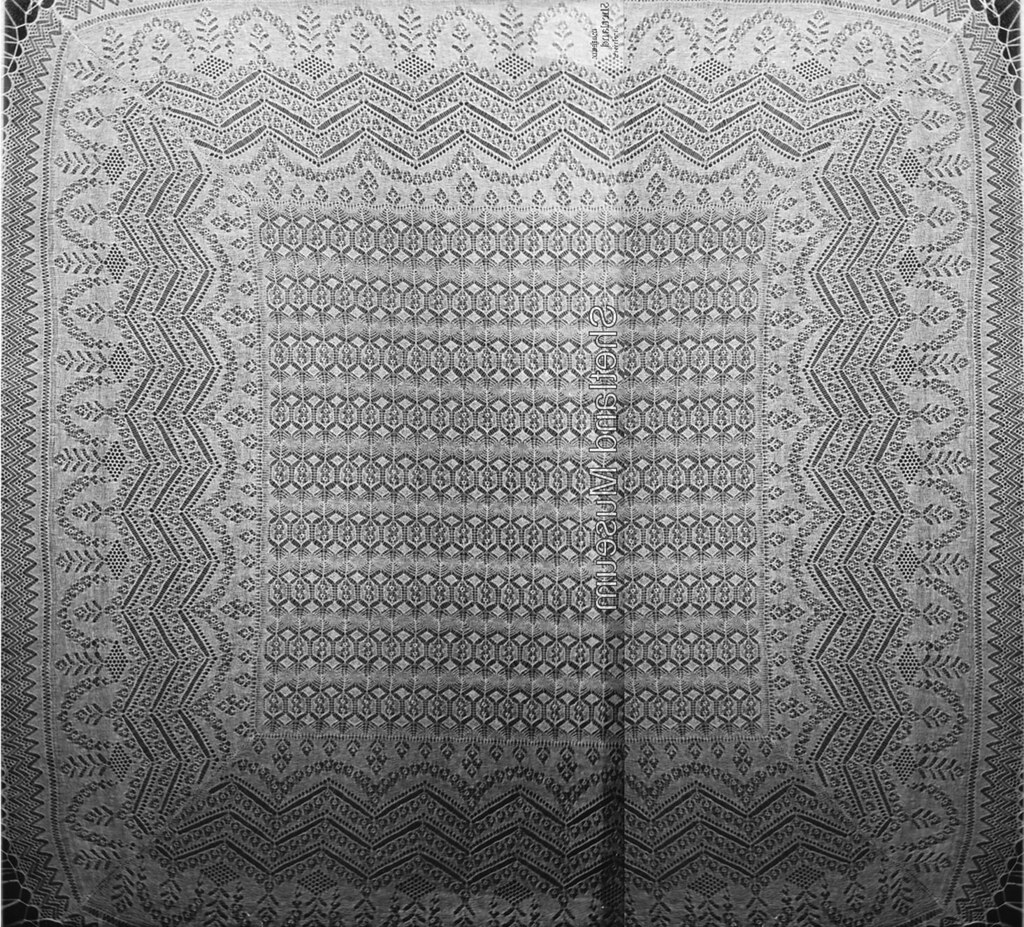The Power of a Knowledge Supermarket: The Queen Susan Shawl
Last time, I described Ravelry as a public knowledge supermarket for knitters. This time, I want to share a major achievement that would not be possible without this knowledge supermarket.
Sometime in the nineteenth century, a craftswoman in the Shetland Islands created an exquisite shawl. She made it out of over a half million stitches using the finest wool available, and her own deep knowledge of traditional lace knitting technique:

Shetland lace shawls are delicate, and this one was apparently damaged after the photograph was taken. The photo is now in the collection of the Shetland Museum in Lerwick.
Last fall, a Ravelry member called Clarabeasty found the photograph on the museum web site and initiated this exchange on Ravelry:
That exchange kicked off a worldwide effort to bring this shawl back to life, through recreating the pattern. By December, fleegle (AKA Susan) had led a team to the finish line, publishing the pattern in a 73 page comprehensive instruction booklet.
They did not just recreate the shawl - they improved it with modern construction techniques that make the work go faster and refinements to the border and center patterns. Today, there are over 30 knitters working on their own interpretations of this pattern.
Ravelry's knowledge supermarket contributed to this in many ways:
Mature knowledge supermarkets open up all kinds of possibilities for teams. If a virtual team with no connection other than the knowledge supermarket can bring a 150 year old lace back to life, what could your team do?
Sometime in the nineteenth century, a craftswoman in the Shetland Islands created an exquisite shawl. She made it out of over a half million stitches using the finest wool available, and her own deep knowledge of traditional lace knitting technique:

Shetland lace shawls are delicate, and this one was apparently damaged after the photograph was taken. The photo is now in the collection of the Shetland Museum in Lerwick.
Last fall, a Ravelry member called Clarabeasty found the photograph on the museum web site and initiated this exchange on Ravelry:
October 16, 2009
Clarabeasty: Does anyone recognize the border pattern on this piece of lace? Specifically the part that looks like little wreaths and twigs.
Sophiphi137: No, but it is beautiful! I also am now very curious about it.
M1K1: Look again in the Shetland Museum photo library. There is a close up detail of another shawl which has the scalloped (wreath) effect made by placing roses.
You can get a really good look at it by selecting Large Image.
Isn’t it a fabulous effect - softening the straight lines of the zigzags.
Actually this might be the same one you showed above...
fleegle: Wow! That’s the most beautiful border I’ve ever seen…..gets out graph paper immediately….
That exchange kicked off a worldwide effort to bring this shawl back to life, through recreating the pattern. By December, fleegle (AKA Susan) had led a team to the finish line, publishing the pattern in a 73 page comprehensive instruction booklet.
They did not just recreate the shawl - they improved it with modern construction techniques that make the work go faster and refinements to the border and center patterns. Today, there are over 30 knitters working on their own interpretations of this pattern.
Ravelry's knowledge supermarket contributed to this in many ways:
- Provided a place where expert lace knitters could build a shared knowledge base of techniques and libraries of patterns so that the knowledge created was commonly understood, believed to be true and actionable, as they individually developed their craft.
- Built relationships between the primary collaborators so that when this challenge arose, the community was ready for it.
- Provided a platform for sharing their work products (pattern charts, photos of swatches, calculations) - and capturing these work products in process so that future projects like this will be able to benefit from their experiences.
- Allowed the collaborators, who were all doing it for the love of the craft, to pull knowledge and the current state of the work products, when they were next able to turn their attention to the project.
Mature knowledge supermarkets open up all kinds of possibilities for teams. If a virtual team with no connection other than the knowledge supermarket can bring a 150 year old lace back to life, what could your team do?

0 Comments:
Post a Comment
<< Home